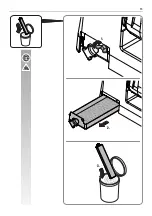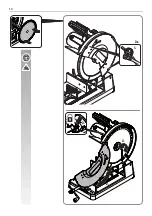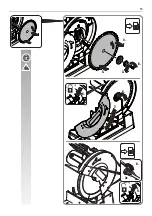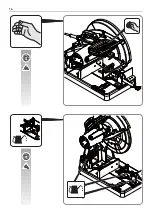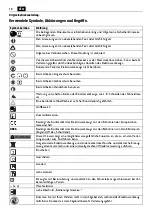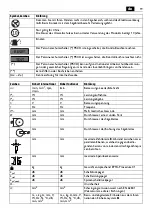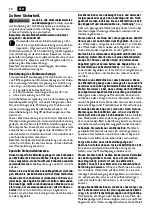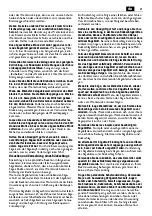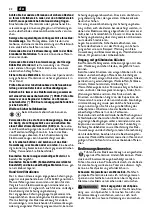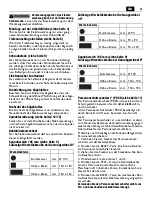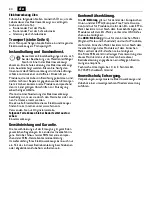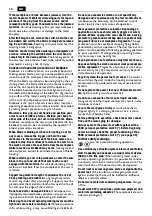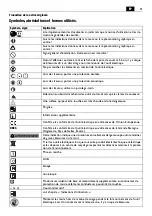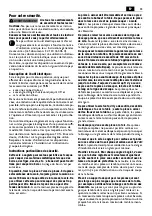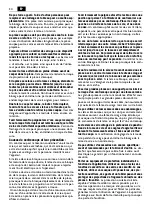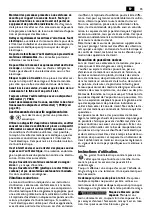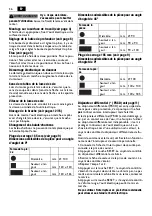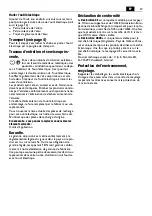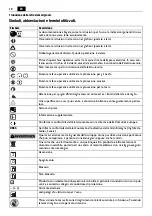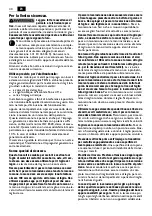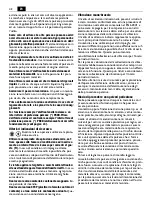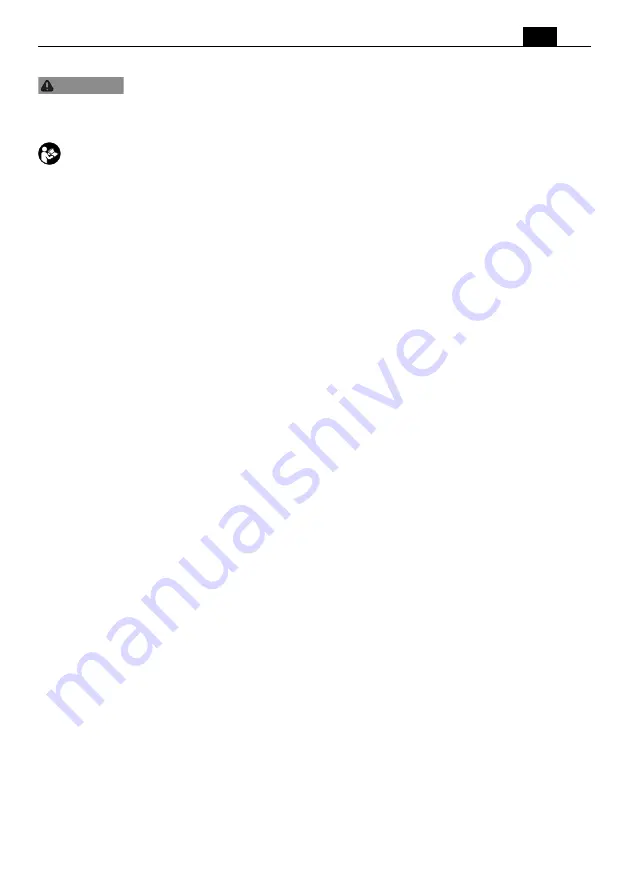
27
en
For your safety.
Read all safety warnings and all
instructions.
Failure to follow the
warnings and instructions may result in electric shock,
fire and/or serious injury.
Save all warnings and instructions for future reference.
Do not use this power tool before you have
thoroughly read and completely understood this
Instruction Manual and the enclosed “General
Safety Instructions” (document number
3 41 30 465 06 0). The documents mentioned should
be kept for later use and enclosed with the power tool,
should it be passed on or sold.
Please also observe the relevant national industrial
safety regulations.
Intended use of the power tool:
Transportable metal chopsaw for use with the applica-
tion tools and accessories recommended by FEIN in
weather-protected environments for lengthways and
crossways cuts in metal materials:
–
with straight cutting sequence and
–
mitre angles to 45° and
–
without the use of water.
In environments subject to interference, a reduction of
the operating quality is possible; this can include tem-
porary failure, temporary reduction of the function or
the intended operating behaviour, for the correction of
which intervention by the operator is required.
This power tool is also suitable for use with AC gener-
ators with sufficient power output that correspond to
the Standard ISO 8528, design type G2. This Standard
is particularly not complied with when the so-called dis-
tortion factor exceeds 10 %. When in doubt, please
refer to the generator instruction/specification guide.
Observe the operating instructions and the national
regulations for the installation and operation of the AC
generator.
Special safety instructions.
The transportable metal chopsaw is intended for cut-
ting metal materials such as rods, bars, screws, etc., it
may not be used for sawing wood.
Sawing wood is not
permitted.
Use clamps to support the workpiece whenever possi-
ble. If supporting the workpiece by hand, you must
always keep your hand at least 100 mm from either
side of the saw blade. Do not use this saw to cut pieces
that are too small to be securely clamped or held by
hand.
If your hand is placed too close to the saw blade,
there is an increased risk of injury from blade contact.
The workpiece must be stationary and clamped or held
against both the fence and the table. Do not feed the
workpiece into the blade or cut “freehand” in any way.
Unrestrained or moving workpieces could be thrown
at high speeds, causing injury.
Never cross your hand over the intended line of cutting
either in front or behind the saw blade.
Supporting the
workpiece “cross handed” i.e. holding the workpiece
to the right of the saw blade with your left hand or vice
versa is very dangerous.
Do not reach behind the fence with either hand closer
than 100 mm from either side of the saw blade, to
remove wood scraps, or for any other reason while the
blade is spinning.
The proximity of the spinning saw
blade to your hand may not be obvious and you may be
seriously injured.
Inspect your workpiece before cutting. If the workpiece
is bowed or warped, clamp it with the outside bowed
face toward the fence. Always make certain that there
is no gap between the workpiece, fence and table along
the line of the cut.
Bent or warped workpieces can twist
or shift and may cause binding on the spinning saw
blade while cutting. There should be no nails or foreign
objects in the workpiece.
Do not use the saw until the table is clear of all tools,
metal waste or cut-offs, etc., except for the workpiece.
Small debris or loose pieces of metal or other objects
that contact the revolving blade can be thrown with
high speed.
Cut only one workpiece at a time.
Stacked multiple
workpieces cannot be adequately clamped or braced
and may bind on the blade or shift during cutting.
Ensure the metal chopsaw is mounted or placed on a
level, firm work surface before use.
A level and firm
work surface reduces the risk of the metal chopsaw
becoming unstable.
Plan your work. Every time you change the mitre angle
setting, make sure the adjustable fence is set correctly
to support the workpiece and will not interfere with the
blade or the guarding system.
Without turning the tool
“ON” and with no workpiece on the table, move the
saw blade through a complete simulated cut to assure
there will be no interference or danger of cutting the
fence.
Provide adequate support such as table extensions,
saw horses, etc. for a workpiece that is wider or longer
than the table top.
Workpieces longer or wider than
the metal chopsaw table can tip if not securely sup-
ported. If the cut-off piece or workpiece tips, it can lift
the lower guard or be thrown by the spinning blade.
Do not use another person as a substitute for a table
extension or as additional support.
Unstable support
for the workpiece can cause the blade to bind or the
workpiece to shift during the cutting operation pulling
you and the helper into the spinning blade.
The cut-off piece must not be jammed or pressed by any
means against the spinning saw blade.
If confined, i.e.
using length stops, the cut-off piece could get wedged
against the blade and thrown violently.
Always use a clamp or a fixture designed to properly
support round material such as rods or tubing.
Rods
have a tendency to roll while being cut, causing the
blade to “bite” and pull the work with your hand into
the blade.
Let the blade reach full speed before contacting the
workpiece.
This will reduce the risk of the workpiece
being thrown.
WARNING
Summary of Contents for MKAS 355
Page 1: ...MKAS 355 7 236...
Page 3: ...3 16 10 13 6 16 4 12 4 8 7 9 11 15 14 5 17...
Page 4: ...4 9 mm 9 mm...
Page 5: ...5 1 2...
Page 6: ...6 1 1 2 1 1 2...
Page 7: ...7 7 8 5 6 3 4 1 2...
Page 8: ...8...
Page 9: ...9 2 6 7 4 3 5 1 185 mm 165 mm...
Page 10: ...10 1 2 4 5 3...
Page 11: ...11...
Page 12: ...12 1 2 3 4 6 7 5 4...
Page 13: ...13 3 1 2...
Page 14: ...14 1 3x 2 3 3...
Page 15: ...15 8 3x 7 6 6 6 3 4 5 9...
Page 16: ...16...
Page 17: ...17 6 mm 6 35 02 301 00 0 8 mm...
Page 66: ...66 el el UKCA a c...
Page 68: ...68 el 3 41 30 465 06 0 FEIN 45 ISO 8528 G2 10 100 mm 100 mm...
Page 69: ...69 el...
Page 70: ...70 el PRCD PRCD 72 RCD CFK EN 62841...
Page 155: ...155 ru ru UKCA a c...
Page 158: ...158 ru...
Page 159: ...159 ru PRCD PRCD 161 CFK EN 62841...
Page 160: ...160 ru 4 6 9 12 15 165 9 0 100 120 x 120 120 x 165...
Page 162: ...162 ru CE UKCA UKCA CE C E Fein GmbH D 73529 Schw bisch Gm nd...
Page 163: ...163 uk uk UKCA a c...
Page 165: ...165 uk 3 41 30 465 06 0 FEIN 45 ISO 8528 G2 10 100 100...
Page 166: ...166 uk...
Page 167: ...167 uk PRCD PRCD 168 CFK EN 62841...
Page 170: ...170 bg bg UKCA a c...
Page 172: ...172 bg 3 41 30 465 06 0 FEIN 45 ISO 8528 G2 10 100 mm 100 mm...
Page 173: ...173 bg...
Page 174: ...174 bg PRCD PRCD 176 FI EN 62841...
Page 196: ...196 zh CM zh CM UKCA a c...
Page 198: ...198 zh CM 3 41 30 465 06 0 FEIN 45 ISO 8528 G2 10 100 100...
Page 199: ...199 zh CM PRCD PRCD 200 FI CFK EN 62841...
Page 203: ...203 zh CK zh CK UKCA a c...
Page 205: ...205 zh CK 3 41 30 465 06 0 FEIN 45 ISO 8528 G2 10 100 100...
Page 206: ...206 zh CK 207 FI CFK EN 62841...
Page 209: ...209 ko ko EU UKCA a c...
Page 211: ...211 ko 3 41 30 465 06 0 FEIN 45 ISO 8528 G2 AC 10 AC 100 mm 100 mm...
Page 212: ...212 ko PRCD PRCD 214 RCD...
Page 213: ...213 ko CFP EN 62841 4 6 9 2 12 15 165 mm 9 0 mm 100 x mm 120 x 120 x mm 120 x 165...
Page 215: ...215 th th UKCA a c...
Page 218: ...218 th...
Page 219: ...219 th PRCD PRCD 221 RCD CFP carbon fiber reinforced polymer EN 62841...
Page 220: ...220 th 4 6 9 12 15 165 mm 9 0 mm 100 x mm 120 x 120 x mm 120 x 165...
Page 223: ...223 ja ja CE UKCA a c...
Page 225: ...225 ja 3 41 30 465 06 0 FEIN 45 ISO 8528 G2 AC 10 100 mm 100 mm 1...
Page 226: ...226 ja...
Page 227: ...227 ja PRCD PRCD 228 CFRP EN 62841 1 4 6...
Page 230: ...230 hi hi UKCA a c...
Page 232: ...232 hi 3 41 30 465 06 0 FEIN 45 AC ISO 8528 G2 10 100 mm 100 mm...
Page 233: ...233 hi...
Page 234: ...234 hi 235 EN 62841 4 6...
Page 236: ...236 hi www fein com FEIN FEIN CE UKCA UKCA CE C E Fein GmbH D 73529 Schw bisch Gm nd...
Page 239: ...239 ar PRCD PRCD 238 FI EN 62841...
Page 240: ...240 ar...
Page 243: ...243 ar UKCA a c...

